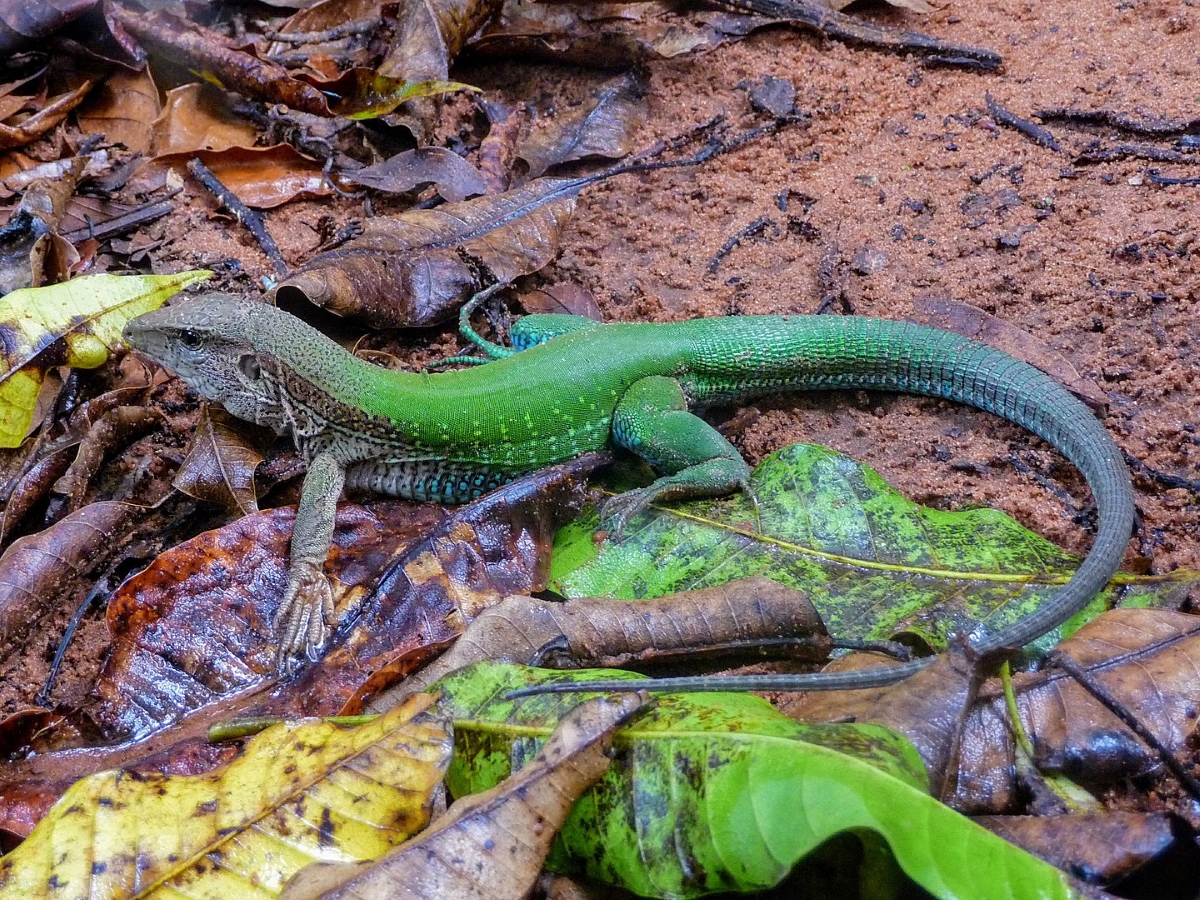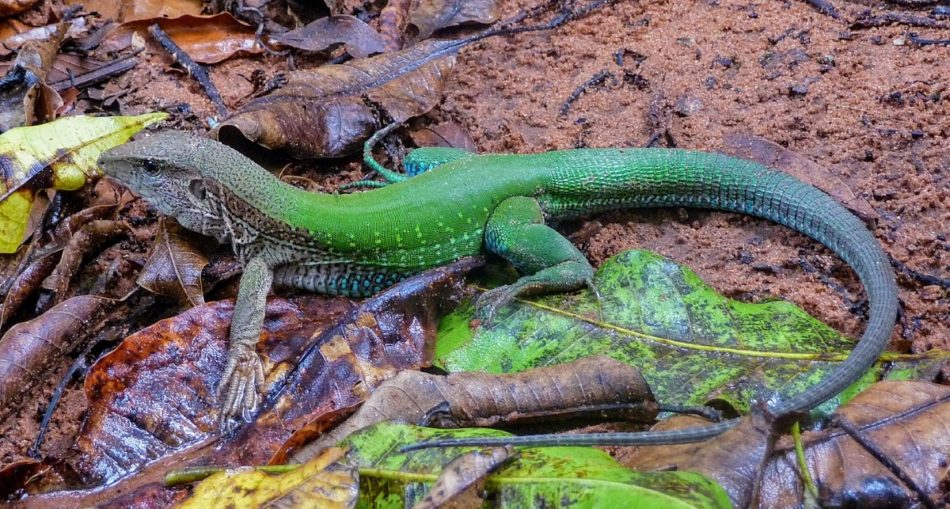The South American Ground Lizard is a very common reptile is also known as the Amazon racerunner, giant ameiva, green ameiva, giant whiptail, jungle runner and zandoli. In Guyana, you can find them scuttling about in yards and burrowing under the soil. They are astonishingly fast runners and hard to get ahold of. Like the name suggests the reptile is native to Guyana, and other South America countries like Suriname, Brazil, Venezuela, Argentina, French Guiana, Bolivia, Ecuador, Peru and Paraguay. It is also found in Panama, Colombia in Central America, and some Caribbean islands such as Grenada, Trinidad and Tobago, Margarita, the Grenadines, Isla de la Providencia Barbados, and Swan Island.
The scientific name of the South AmericanGround Lizard is Ameiva ameiva and there are nine (9) subspecies including the Ameiva ameiva ameiva, Ameiva ameiva fischeri, Ameiva ameiva fulginosa, Ameiva ameiva laeta, Ameiva ameiva melanocephala, Ameiva ameiva ornata, Ameiva ameiva petersi, Ameiva ameiva praesignis, and Ameiva ameiva vogli.

A South American Ground Lizard – Photo By Gionorossi – Own work, CC BY-SA 4.0, https://commons.wikimedia.org/w/index.php?curid=69134449
Description Of The South American Ground Lizard
The South American Ground Lizards are medium-sized and weigh about sixty (60) g. Their bodies are long about eighteen to twenty (18–20) inches with strong muscular hinds legs. One of the main features of the reptile is their snout, which can be as high as one hundred and eighty (180) mm high in males and one hundred and sixty (16)) mm in females. Their heads are about eighteen (18)mm. The lizards have pores about one (1) mm in size; the males have about seventeen to twenty-three (17-23) while the females have about sixteen to twenty-two (16-22).
The adults of the species share green colour but the females have a more dusty colour, and the males a bright green and bolder mottling. While the adults have yellow lines on the dorsal parts of their bodies, the juveniles have white lines. The rest of their bodies are dark-brown but their ventral side is white/ivory and covered in smooth scales.
Scientific Classifications Of The South American Ground Lizard
- Kingdom: Animalia
- Phylum: Chordata
- Class: Reptilia
- Order: Squamata
- Family: Teiidae
- Genus: Ameiva
- Species: A. ameiva
Diet and Nutrition of The South American Ground Lizard
The diet of the South American Ground Lizard depends on the seasons and the areas where they live, however they are active foragers. Typically the lizard eats insects, like butterflies, beetles, grasshoppers, roaches, spiders, termites and frogs. Sometimes they even prey on different lizard species.
Habitat of The South American Ground Lizard
The lizard can be found in a wide variety of tropical and terrestrial habits including the Amazonian savannah and forests, the cerrado of Brazil, a vast tropical savannah ecoregion and the caatinga, which is desert vegetation. Giant Ameiva lives on the floor of the forests, hiding under logs and between fallen leaves. In captive, they were observed to make tunnels under logs and rocks where there is enough soil.
Behaviour of The South American Ground Lizard
There is not much information on the behaviour of the lizards but they are diurnal and tend to be alone. They are not territorial. Their home range is determined by the femoral glands on the ventral underside of their hind limbs. Semiochemicals from these glands are believed to affect the self-defence and territory, predation, territorial markings, and parental care. The South American Ground Lizard is preyed upon by green snakes, roadside hawks, kestrels, housecats and mongoose. Their bodies are designed for speed, allowing them to escape from predators in foraging areas.
Reproduction Of The South American Ground Lizard
It is believed that the reproduction of the Ameiva ameiva is similar to the Ameiva plei. They guard the females during mating and those that did not were unable to mate. These lizards lay their eggs in clutches ranging from three to eleven eggs (3-11). The larger females tend to produce more eggs, compared to the smaller lizards. The South American Ground Lizard can lay as much as three (3) clutches per season usually from March to December but they may reproduce throughout the year. However, this depends on the season, since they reproduce during the rainy season due to the lack of food during dry seasons.
The female would stay in her burrow while carrying the eggs. They incubate the eggs for about five (5) months. The offsprings usually hatch when there is plenty of food, at the beginning of the rainy season. Both male and female lizards mature about eight (8) months after hatching. This is recognized when their snout-vents length reaches one hundred (100) mm.
Interesting Facts About the South American Ground Lizard
- Giant Ameivas in captivity tends to favour mealworms.
- Their food depends on the size of their snout-vent.
- These lizards like recently disturbed rainforests where harvesting was done.
- They seem to prefer disturbed rain forests that have recently been harvested.
- The size of their snout is a factor in the size of their clutches size.
- The females are able to lay as much as three (3) clutches during the reproductive season and invest a lot nutrients in them
- Females grow at a slower rate than their counterparts.
- Giant Ameiva are believed to have a lifespan of about three to five (3-5) years.
- They are popular as a pet because of the male’s striking green colouration.
- While the South Ameican Lizards may carry disease, they are popular pets because of their vibrant, attractive green colours.
- The lizards also help to control pest populations.
About The South American Ground Lizard
The South American Ground Lizards are fairly interesting creature and should not be mistaken for the gigantic guanas. The replies also have the fantastic ability to regrow their tails which are sometimes cut off during an escape from predators. However, their tails regrow soon enough. If you spot this lizard in your yard, they are most likely foraging for food. They rarely allow you to get near and will hurry away as soon as you near them, so observe these interesting reptiles from afar. Have you ever spotted them in your surroundings? Comment below and let us know!
Article Reference
- https://en.wikipedia.org/wiki/Ameiva_ameiva
- https://animaldiversity.org/accounts/Ameiva_ameiva/#lifespan_longevity
- https://sta.uwi.edu/fst/lifesciences/sites/default/files/lifesciences/images/Ameiva%20ameiva%20-%20Zandolie%20or%20Jungle%20Runner.pdf
- https://www.kaieteurnewsonline.com/2020/04/26/interesting-creatures-the-giant-ameiva-ameiva-ameiva/







